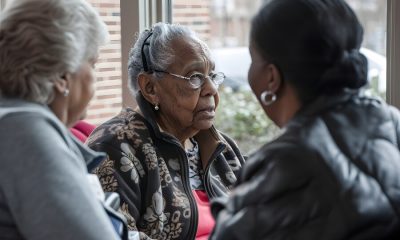BY SIMONE J. SMITH
The holiday season, a time often associated with joy and celebration, can paradoxically trigger a decline in mental well-being for many. Coupled with the ongoing pressures of inflation, rising crime rates, and the abrupt shift of daylight savings time, particularly in northern regions, these factors can create a perfect storm for individuals struggling with their mental health.
Suicide, a tragic reality, knows no boundaries, impacting people of all ages and backgrounds. In Canada alone, a staggering average of 4,500 lives are lost to suicide each year, translating to approximately 12 individuals per day. The impact of each suicide extends far beyond the individual, leaving a trail of grief and devastation among family, friends, and communities.
On November 30th, 2023, Canada launched 9-8-8 Suicide Crisis Helpline. It is for anyone thinking about suicide, feeling hopeless, or like they are struggling to cope. The Centre for Addiction and Mental Health (CAMH) in Toronto, Canada’s largest mental health teaching hospital, leads and coordinates delivery of 9-8-8 nationwide. 9-8-8 is funded by the Government of Canada, through the Public Health Agency of Canada.
A growing network of nearly 40 experienced local and national crisis line partners across the country provide culturally appropriate, lifesaving supports to people who call or text the helpline.
Over the past year, 9-8-8 crisis responders have answered more than 300,000 calls and texts to the national helpline. 9-8-8 answers an average of almost 30,000 calls and texts per month – approximately 1,000 calls and texts per day. In Ontario, 9-8-8 responders answer an average of over 12,000 calls and texts per month (more than 135,000 from the launch to October 31st, 2024).
The goal of the three-digit helpline is to prevent suicide by making it as simple as possible for people to get the help they need, when they need it most. 9-8-8 provides urgent, live support by phone and text to people in every province and territory across the country in English and French, 24/7, every day of the year.
Last week, I had a chance to speak with Nika Khossravi, 9-8-8 Crisis Responder, and she shared with me her reason for becoming a responder, and the importance of 9-8-8.
“Last year I experienced the loss of a friend to suicide,” Nika shares, “When I was grieving the loss, I did a lot of reflection, and I realized that I did not have the tools to assist my friend. I dug deep and volunteered and learned a lot. What many of us don’t take into consideration is how suicide affects survivors of suicide. We don’t like to say suicide is contagious, but sometimes it becomes more of a reality, especially when someone close to you has committed suicide.”
“What are the biggest challenges you anticipate in ensuring equitable access to the 9-8-8 helpline for all Canadians, including those in remote, rural, and underserved communities,” I inquired?
“It serves every single city in Canada. It is the same as 9-1-1. Let’s be honest, when you are in crisis, you are not thinking about long drawn-out numbers. We want 9-8-8 to become as familiar as dialing 9-1-1,”
“Are there mechanisms for seamless referrals and follow-up care?”
“Responders offer follow calls within 24 hours, and some are able to do referrals to local distress centres. 211 is one of the resource databases that we can provide for them.”
9-8-8 also offers support and advice for people who are worried someone they know may be considering suicide. Whatever you are going through, you don’t have to face your problems on your own. 9-8-8 responders are here to listen. No one who calls or texts 9-8-8 will be turned away. Everyone who contacts 9-8-8 will be assessed for suicide risk.
“What are the initial expectations and long-term goals for the 9-8-8 helpline in terms of reducing suicide rates and improving mental health outcomes for Canadians?”
“We want people to be aware. We are a resource to those who think someone in their lives might be thinking about suicide. We want 9-8-8 to be as familiar to Canadians as 9-1-1.”
By texting or calling 9-8-8, people can connect with a responder who’s ready to
listen and trained to help. 9-8-8 responders work with callers and texters to explore ways to cope when things are overwhelming and find a path to safety. Responder training is informed by evidence, best practices and engagement with organizations representing populations most affected by suicide to ensure that anyone, anywhere, can access the support they need.
For more information and to receive the latest updates, please visit www.988.ca or connect with them on our social media platforms:
Twitter: @988Canada
Facebook: 988Canada
Instagram: @988Canada
LinkedIn: 988Canada


 Community News1 week ago
Community News1 week ago
 Community News1 week ago
Community News1 week ago
 Community News1 week ago
Community News1 week ago
 Community News1 week ago
Community News1 week ago
 Community News1 week ago
Community News1 week ago
 Community News1 week ago
Community News1 week ago
 Classic Man7 days ago
Classic Man7 days ago
 Classic Man7 days ago
Classic Man7 days ago


























